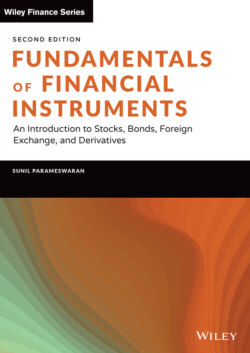Читать книгу Fundamentals of Financial Instruments - Sunil K. Parameswaran - Страница 71
На сайте Литреса книга снята с продажи.
THE FISHER EQUATION
ОглавлениеLet us consider a hypothetical economy which is characterized by the availability of a single good, namely chocolates. The current price of a box is $P0. Thus, one dollar is adequate to buy 1/P0 boxes of chocolates at today's prices. Let the price of a box after a year be $P1. Assume that while P1 is known with certainty right from the outset, it need not be equal to P0. In other words, although we are allowing for the possibility of inflation, we are assuming that there is no uncertainty regarding the rate of inflation. If the price of a box at the end of the year is P1, one dollar will be adequate to buy 1/P1 boxes after a year.
Let us assume that there are two types of bonds that are available to a potential investor. There is a financial bond that will pay $(1 + R) next period per dollar that is invested now, and then there is a goods bond which will return (1 + r) boxes of chocolates next period per box that is invested today. An investment of one dollar in the financial bond will give the investor dollars (1 + R) next period, which will be adequate to buy (1 + R)/P1 boxes. Similarly, an investment of one dollar in the goods bond or 1/P0 boxes in terms of chocolates will yield (1 + r)/P0 boxes after a year.
In order for the economy to be in equilibrium, both the bonds must yield identical returns. Thus, we require that
Inflation is defined as the rate of change in the price level. If we denote inflation by π, then
Therefore
This is the Fisher equation. R or the return on the financial bond is the nominal rate of return, while r or the rate of return on the goods bond is the real rate of return. Thus, the relationship is that one plus the nominal interest rate is equal to the product of one plus the real interest rate and one plus the rate of inflation. If the real rate of interest and the rate of inflation are fairly small, then the product will be of a much smaller order of magnitude. For instance, if r = 0.03 and , then . If so, we can ignore the product term and rewrite the expression as
This is called the approximate Fisher relationship.
In Example 2.1, the nominal rate of return was 10% while the rate of inflation was 25%. Thus, the real rate was .
